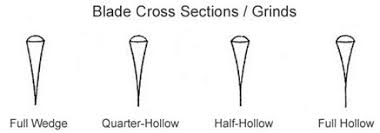Results 1 to 6 of 6
Thread: Figuring out the grind
-
11-07-2017, 10:21 PM #1
 Figuring out the grind
Figuring out the grind
Here are two different images I've pulled off the web. Do you think image #1 or #2 is correct?
Image #1:

Image #2:

What I'm looking at is a grind that goes half way down the razor. I would think that is a half hollow. But, I've rot razors that are marked as Extra hollow but still only go half way down. I would say a full hollow is ground so that it looses its thickness about 1/3 of the way down the blade.
Comments? What do you feel is more correct?It's just Sharpening, right?
Jerry...
-
The Following User Says Thank You to Gasman For This Useful Post:
jseitz (11-09-2017)
-
11-07-2017, 10:49 PM #2Senior Member



- Join Date
- Mar 2012
- Location
- Thunder Bay, Ontario, Canada
- Posts
- 17,348
Thanked: 3228
Near as I can tell both are correct but image #2 just has more grinds illustrated. You have to consider also that the definitions of what is a full hollow ground seems to have changed over time. I'd swear that some of the Sheffield razors I have that are marked full hollow ground are really half hollow ground by today's standards.
My guess is that as the industry got better at grinding moving away from near wedges the grinds got progressively finer and finer. What at one time was considered a full hollow ground was no longer finely ground enough to be considered that. My guess is that is why image#2 has more types of hollow ground listed between wedge and bellied hollow.
That is my story and I am sticking to it.
BobLife is a terminal illness in the end
-
The Following User Says Thank You to BobH For This Useful Post:
Gasman (11-07-2017)
-
11-07-2017, 11:28 PM #3

Thanks for your reply Bob.
I'm going thru my razors right now and entering them in my spreadsheet. I just came across one made in the early 1900's, marked as Extra Hollow ground, but if you ask me, its more of a "Quarter Hollow". Maybe when they compare all the razors THEY make, it was one that had much more grind. But no where near Extra Hollow in my opinion!It's just Sharpening, right?
Jerry...
-
11-08-2017, 12:39 AM #4Senior Member



- Join Date
- Mar 2012
- Location
- Thunder Bay, Ontario, Canada
- Posts
- 17,348
Thanked: 3228
Yea, the early 1900s were not all that far away from the hay day of the heavier grinds so it may have been extra hollow compared to the others they made at that time. By modern standards it would be nowhere near extra hollow ground. I gave up on what grinds they. I just hone them and shave with them.
BobLife is a terminal illness in the end
-
11-08-2017, 12:37 PM #5Senior Member

- Join Date
- Nov 2016
- Location
- Chicago Suburbs
- Posts
- 1,104
Thanked: 292
If you are looking at a 5/8" blade then Image 1 might be correct, but if you are looking at a 7/8" blade then Image 2 is more realistic. The hollowness of the grind depends largely upon the diameter of the grinding wheel. Thus, if you take a similar size wheel on both 5/8 and a larger blade, the percentage of the blade that is thin is going to be greater on the larger blade.
-
The Following User Says Thank You to RayClem For This Useful Post:
Gasman (11-08-2017)
-
11-08-2017, 12:53 PM #6

I've seen image #2 before and my eyes always go to the "faux frameback" because this one is a point of confusion sometimes. I think what it is showing there is actually a rattler grind. The way I understand it is a frameback has a blade that is separate from the tang and spine (correctly represented above imo), a faux frameback has tang, spine, blade as one piece with a separate piece of metal wrapped around the spine, and a rattler is like what image #2 shows as being a faux frameback. So we end up with people sometimes referring to a rattler as a faux frameback. Right?...maybe
"Go easy"
-
The Following User Says Thank You to xiaotuzi For This Useful Post:
jseitz (11-09-2017)


 8Likes
8Likes
 LinkBack URL
LinkBack URL About LinkBacks
About LinkBacks







 Reply With Quote
Reply With Quote
